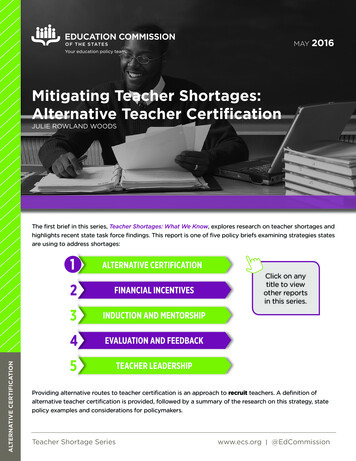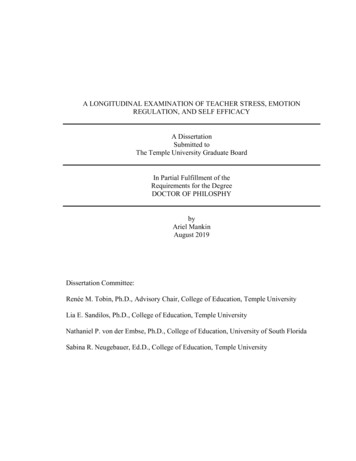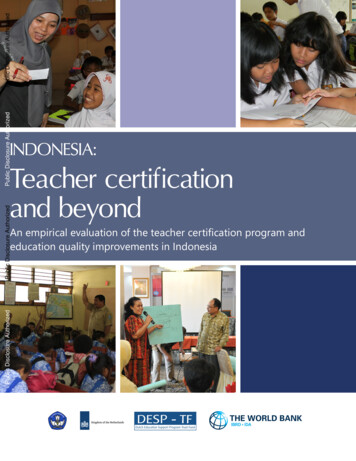
Transcription
Public Disclosure AuthorizedPublic Disclosure AuthorizedINDONESIA:Public Disclosure AuthorizedTeacher certificationand beyondPublic Disclosure AuthorizedAn empirical evaluation of the teacher certification program andeducation quality improvements in Indonesia
The Word Bank Office JakartaIndonesia Stock Exchange Building, Tower II, 12th floorJl. Jend. Sudirman Kav. 52-53Jakarta 12190Tel: ( 6221) 5299-3000Fax: ( 6221) 5299-3111http://www.worldbank.org/idPublished in December 2015Cover photo courtesy by The World Bank – JakartaTeacher certification and beyond: An empirical evaluation of the teacher certification program and educationquality improvements in Indonesia is a product of the staff of the World Bank. The findings, interpretation, andconclusions expressed herein do not necessarily reflect the view of the World Bank, its board of Executive Directors,officers or any of its member countries.The World Bank does not guarantee the accuracy of the data included in this work. The boundaries, colors, denominations,and other information shown on any map of this work do no imply any judgment on the part of the World Bankconcerning the legal status of any territory or the endorsement or acceptance of such boundaries.The work is funded by the Government of the Kingdom of the Netherlands under the Dutch Education Support Program(DESP) Trust Fund. DESP provides support to the Government of Indonesia through the World Bank for the purpose ofdeveloping policies, studies, and programs that help the government achieve its education strategic plan.
Report No. 94019-IDINDONESIA:Teacher certification and beyondAn empirical evaluation of the teacher certification programand education quality improvements in IndonesiaEducation Global PracticeEast Asia and Pacific Region
Regional Vice President Axel van TrotsenburgCountry Director Rodrigo A. ChavesSenior Practice Director Claudia CostinPractice Manager Harry PatrinosTask Team Leader Andrew Ragatz
ContentsAcknowledgementsviAcronyms and AbbreviationsviiPreface9CHAPTER 1One decade on for teacher certification in Indonesia12CHAPTER 2An empirical review of the teacher certification program in Indonesia162.1. The behavioral channel: Does paying teachers double make them teach better?192.2. Academic upgrading of in-service teachers: Does it help, and does it help enough?262.3. Attracting better-quality aspiring teachers into the teaching profession30CHAPTER 3Beyond certification: what matters and what doesn’t matter for student learning?343.1. How much do Indonesian students learn in a year?343.2. Differences in quality across schools and teachers in Indonesia363.3. Which observable characteristics of teachers matter?383.3.1. The reality of improving the subject-matter knowledge of teachers41CHAPTER 4Policy options for sizable and lasting changes in education quality464.1. Pre-service teacher training and teacher hiring474.2. In-service teacher continuous professional management and teacher quality upgrading49ANNEXA. The survey data52B. Teacher value-added: estimating the distribution of school and teacher quality across Indonesian primaryclassrooms55C. More empirical results of value-added models60D. Learning profiles, how much children learn in a year65Bibliography69
FiguresFigure 1: A representative sample of 20 districts was selected to take part in this longitudinal survey15Figure 2: Eligibility for certification in 2005/06, by school type17Figure 3: Matrix of the different types of teachers and the mechanisms by which overall performance ofthe teacher workforce might improve19Figure 4: The number of certified teachers, by year of certification20Figure 5: Differences between treatment and control at baseline (November 2009), one month after theintervention22Figure 6: Fraction of teachers who are certified and paid, at baseline, midline and endline23Figure 7: Certification allowance disbursed per teacher, on a per month basis24Figure 8: Fraction of teachers reporting financial stress (selected on “targets” only)24Figure 9: Fraction of teachers with a second job (selected on “targets” only)25Figure 10 : Student learning outcomes across treatment and control25Figure 11 : Percentage of teachers with bachelor’s degrees, by school type, by year27Figure 12 : What might happen to aggregate student-learning outcomes when all teachers obtain a bachelor’s29degree in the next 5 years?ivFigure 13 : Long-term projected effects of better quality teacher intake on mathematics achievement31Figure 14 : Learning gains from grade to grade35Figure 15 : Projected differences in learning outcomes across primary and junior secondary school of two,otherwise identical students38Figure 16 : Scores on test Question 1, by overall score decile42Figure 17 : Scores on test Question 2, by overall score decile43Figure 18 : Predicted performance on test Question 1 after a one standard deviation increase in subjectmatter knowledge, by overall score decile44Figure 19 : Predicted performance on test Question 2 after a standard deviation increase in subject-matterknowledge, by overall score decile44Figure 20 : Efforts to increase subject-matter knowledge of Indonesian teachers could rapidly translate intoimproved student outcomes45Figure 21 : Percentage of primary school teachers (aged between 24-30 years of age) without a universitybachelor’s degree48Figure 22 : Effect of having a teacher with a bachelor’s degree, on learning outcomes63Figure 23 : Schematic representation of the anchor test design: all test forms are linked horizontally andvertically, but not diagonally65
TablesTable 1: Estimates of the standard deviation of classroom effects across Indonesian public primary schools58Table 2: Averages of some of the variables used in the analysis61Table 3: Results from empirical value added modeling62Table 4: The difference between 3rd graders and 4th graders, in terms of learning levels67Table 5: The difference between 5th graders and 6th graders, in terms of learning levels68v
AcknowledgementsThis report was written by Joppe de Ree and most of the research was executed under his lead, while working for theWorld Bank office in Indonesia. The report, however, could not have been written without the help of a large group ofpeople, who, at different times, have assumed important roles and responsibilities all contributing towards the successfulcompletion of this work. The research was set up in 2008, as one of the research projects under the Better Educationthrough Reformed Management and Universal Teacher Upgrading (BERMUTU) program. In this, the World Bank workedin a unique and longstanding partnership with Indonesia’s Ministry of Education and Culture. The research was generouslysupported by the Government of the Netherlands, under the Dutch Education Support Program.The research project was from the design planned as a randomized controlled trial, with the intention of rigorouslyevaluating the process of certification, and the impact of paying teachers double on their behavior and on studentlearning outcomes. The randomized controlled trial was initiated by Menno Pradhan (then World Bank) partnering withKarthik Muralidharan (University of California, San Diego) and Halsey Rogers (World Bank). Subsequently, the projectmanagement was taken over by Amanda Beatty, with the continuing support of Menno Pradhan, Karthik Muralidharanand Halsey Rogers. In 2010 Joppe de Ree took over the project management and the analytical work, until the completionof this document. Various colleagues in the World Bank have often played a pivotal role in the success of the project.Susiana Iskandar, Titie Hadiyati (and team) and Dedy Junaedi (and his teams of enumerators throughout the country,data managers, data cleaners, people he affectionately calls “our friends”) have been indispensable and, without them,this work would not have been possible. The government teams were equally important for the success of this project.Ibu Dian Wahyuni and Ibu Santi Ambarukmi (both Pusat Pengembangan Profesi Pendidik, Pusbangprodik) managedthe implementation of the “the intervention” of the randomized trial, by making sure that prequalified teachers in therandomly selected treatment schools received accelerated access to the certification process. In Pusat Penelitian Kebijakan(Puslitjak), particular thanks go to Ibu Yendri Wirda Burhan, Pak Simon Silisabon (and team); and in Pusat PenilaianPendidikan (Puspendik), particular thanks go to Ibu Dhani Nugaan, Pak Bastari, Pak Hari Setiadi, Ibu Rahmawati and IbuYani Sumarno (and team). Together with various others over the years they have taken on exceptional responsibilities inthe design and implementation of this research project. Subsequent to collecting and organizing the data, the researchactivities have also benefited from senior government consultants, such as Pak Jiyono and Pak Yahya Umar.The content of this report is the culmination of years of researching the data. Various people have played a key role inthis process. Co-authors on different projects related to this work, such as Mae Chu Chang, Sheldon Shaeffer, Samer AlSamarrai, Andy Ragatz, Ritchie Stevenson, Susiana Iskandar, Karthik Muralidharan, Halsey Rogers and Menno Pradhan,have helped shape ideas for this report. In-depth discussions also took place on the content of various earlier drafts ofthis report, notably with Samer Al-Samarrai, Andrew Ragatz, Susiana Iskandar, and Ratna Kesuma. Over the years, theresearch has been supported by research assistants Ai Li Ang, Husnul Rizal and Laura Wijaya. In the final stages, this reporthas benefited substantially from editorial assistance of Peter Kjaer Milne, graphic design and production support fromYvonne Armanto and Santi Santobri, and last but not least, thoughtful and generous peer reviewer comments from LantPritchett, Tazeen Fasih and Daniel Suryadarma. Thank you all!vi
Acronyms and AbbreviationsAECASEAN Economic CommunityASEANAssociation of Southeast Asian NationsBalitbangResearch and Development BoardBERTUMUBetter Education through Reformed Managementand Universal Teacher UpgradingBOSSchool Operational AssistanceBantuan Operasional SekolahBPSBPS-Statistics IndonesiaBadan Pusat StatistikCPDContinuous Professional DevelopmentCTLContextual Teaching and LearningEdstatsWorld Bank Education Statistics DatabaseGDPGross Domestic ProductGTTSchool-hired temporary teachersIDRIndonesian RupiahINPRESPresidential InstructionInstruksi PresidenLPTKTeacher Education InstitutionLembaga Pendidikan Tenaga KependidikanMenPANMinister of Administrative and Bureaucratic ReformMenteri Negara PendayagunaanAdministrasi Negara dan ReformasiBirokrasiMoECMinistry of Education and CultureMoRAMinistry of Religious AffairsNUPTKUnique Identification Number for Teachers andTeaching PersonnelOECDOrganisation for Economic Co-operation andDevelopmentPISAProgram for International Student AssessmentPLPGEducation and Training for the Teaching ProfessionPendidikan dan Latihan Profesi GuruPuslitjakCenter for Policy Research, Ministry of Education andCulturePusat Penelitian KebijakanPuspendikEducational Assessment Center, Ministry of EducationPusat Penilaian Pendidikanand CultureRCTRandomized Controlled TrialSDPrimary SchoolSekolah DasarSMPJunior Secondary SchoolSekolah Menengah PertamaSMASenior Secondary SchoolSekolah Menengah AtasSMKVocational Secondary SchoolSekolah Menengah KejuruanTIMSSTrends in International Mathematics and ScienceStudyUGKTeacher Competency ExamUSDUnited States DollarUTOpen UniversityBadan Penelitian dan PengembanganGuru Tidak TetapNomor Unik Pendidik dan TenagaKependidikanUjian Kompetensi GuruUniversitas Terbukavii
Nearly a decade ago in 2005, Indonesia passed Law No. 14/2005 on Teachers and Lecturers. By far the largest componentof the law, at least in terms of its fiscal implications, was the teacher certification program. The certification programaimed to certify all teachers by 2015. The program was rolled out at a rate of approximately 200,000 teachers eachyear. With more than 2 million teachers to certify, the process was meant to take 10 years.1 The rollout is now welladvanced and government statistics show that 1.15 million teachers were certified in 2012. As teachers completed thecertification process, they were eligible for a certification allowance, equal to their base salary in the civil service. In manycases therefore certification doubled a teacher’s take-home pay. Certification comes with a serious price tag: if theprogram is fully implemented it would cost more than USD 5 billion each year, roughly a quarter of the overall educationbudget. In order to prequalify for certification, teachers must have a university bachelor’s degree or equivalent, althoughexemptions to this rule were introduced for senior teachers.This report evaluates the certification program as it was implemented, in terms of its impact on student-learningoutcomes. Results of the analysis are sobering: despite its massive fiscal implications, the certification program has notled to substantial improvements in student-learning outcomes so far. However, the report provides leads into how togradually transform the system into one that can yield higher returns in educational performance going forward. Itemphasizes the importance of a system that rewards useful demonstrated competencies, such as minimum levels ofsubject-matter knowledge, rather than loose proxies for quality such as bachelor’s degrees or seniority alone (which isessentially what the current certification program does). The report also highlights the need for reforms in the pre-servicesystem of teacher training and teacher hiring.The findings and conclusions of this report are drawn from 6 years of collecting and researching micro level data in aunique partnership between the Government of Indonesia and The World Bank. A geographically representative sampleof 360 Indonesian public primary and junior secondary schools were visited three times in a period of 2.5 years, and theacademic development of tens of thousands of students were tracked throughout this period. The academic performanceof students across time was then linked to survey information and subject-matter test scores of their teachers. Based onthis unusually rich, matched student-to-teacher data base we analyze the impact of certification on student learningoutcomes (in Chapter 2), but we also look much deeper into “how much students learn in a year in school” and the roleof their teachers in supporting their learning process (in Chapter 3).Four main, general conclusions are drawn from the data analysis presented in this report: Conclusion #1. Paying teachers more does not make them teach better. Conclusion #2. Teachers with bachelor’s degrees are only moderately better teachers than teachers withoutbachelor’s degrees. This is especially true for primary school teachers. Conclusion #3. Teachers with a reasonable level of subject-matter knowledge are much better teachers thanteachers who have difficulties with even the most basic mathematical exercises. Hundreds of thousands of primaryteachers in Indonesia have difficulties with even the most basic mathematical exercises. Conclusion #4. Teacher training colleges produce 250,000 university trained teachers each year, whereas the schoolsystem needs only 50,000 – 100,000.1Most teachers in the early years of certification were certified through a successful portfolio assessment of past training and experiences.Later, most teachers followed a 90-hour training program.INDONESIA: Teacher certification and beyond An empirical evaluation of the teacher certification program and education quality improvements in IndonesiaPreface9
Based on these general conclusions we analyze the potential effect of the certification program in the short, mediumand longer term (Chapter 2 of this report). The “effect” of certification is a combination of three forces working together.The three complementary forces are the behavioral mechanism, the academic upgrading mechanism, and the attractionmechanism.The behavioral mechanism. Teachers who are certified are paid more. Some theories predict that higher salaries couldincrease effort, and/or allow teachers to spend more time on lesson preparation for example (by spending less onoutside employment).2 This behavioral mechanism applies to all teachers who are certified and receive the certificationallowance. We learn from conclusion #1 however that the behavioral mechanism does not stand up to empirical scrutiny:paying teachers more decreases their reliance on outside employment, it also decreases (self-reported) financial stress,10The academic upgrading mechanism. About half of all teachers did not prequalify for certification when the programINDONESIA: Teacher certification and beyond An empirical evaluation of the teacher certification program and education quality improvements in Indonesiabut it does not make teachers teach better.3other words, the certification allowance provided a massive financial incentive for half of the teaching force to “go backwas introduced nearly a decade ago. These teachers had to obtain a bachelor’s degree first, in order to prequalify. Into school”. And indeed many in-service teachers did exactly that, most of them through remote learning courses. In 2012,55 percent of all primary teachers had a bachelor’s degree or equivalent, up from only 17 percent in 2005/06. But fromconclusion #2 we conclude that this wave of academic upgrading led to only moderate improvements in educationquality. With limited supervision on the competency levels teachers attain in the process of obtaining their degrees,minimum quality standards are not guaranteed. Competency “on paper” (bachelor’s degrees) are not necessarily on a parwith competency “in reality” (skills that are useful for teaching). Based on the analysis presented in Annex C and Section2.2 we forecast that when all teachers in the system have obtained a university bachelor’s degree, student-learningoutcomes in the aggregate will only increase by 0.16 of a standard deviation, or, if we rely on the scaling used by theProgramme for International Student Assessment PISA, by roughly 11 PISA points. These effects are not nearly enough toclose half of the gap in educational performance between Indonesia and, say, Thailand and Malaysia.The attraction mechanism. A partial aim of the certification program was to provide incentives for the brightest highschool graduates to pursue a career in teaching, by making the profession much more attractive financially. While the basesalary of a junior teacher in the civil service compares roughly to the salary level of the median worker with a universitybachelor’s degree, the base salary plus the certification allowance compares to the 90th percentile. Today, we cannot yetprecisely assess the efficacy of this mechanism, as the impact of attraction should only become measurable in increasededucational performance over the next 10 to 20 years. But the report argues that it is questionable that attraction willsuccessfully increase education quality in the medium term, unless today’s pre-service system is carefully amended. Fromconclusion #4 we learn that teacher training colleges currently produce too many university trained teachers. At thesame time, districts and schools do not appear to hire the best, or even the best trained candidates out of this large poolof job-seekers. Government statistics show that approximately 50 percent of junior primary school teachers in the civilservice do not have a university bachelor’s degree. With massive overproduction of teachers, combined with unclear andpotentially unfair hiring rules, the chances of finding a secure and well-paid teaching position are slim, even for the highcaliber candidates. When high-school graduates internalize the poor career prospects in teaching, the brightest amongthem should opt out first, because they have more and better outside options. The current system, therefore, potentiallyachieves the opposite of what it intended: deterring rather than attracting high-caliber high-school graduates to pursuea career in teaching.The findings of this report confirm what many skeptics of the current program had already anticipated, or feared perhaps,when the certification program was introduced nearly a decade ago. In the mean time, however, competency testing has23See Akerlof & Yellen (1990) for example for background.See Section 2.1 for a discussion of the empirical results and the design of the randomized controlled trial. Also, see De Ree, Muralidharan, Pradhan, & Rogers(forthcoming) for more details and results on the experiment.
who failed initially to embark on a process of professional development to improve competencies, with the purpose todo better in one of the later rounds. In this way, the system started to incentivize improvements in quality. In the reportwe argue that these are steps in the right direction. But a system that directly rewards useful demonstrated competenciescould benefit from a more rigorous implementation (see Chapter 4 for a discussion). Annex C and Section 3.3 of thisreport show that improvements in the level of teachers’ subject-matter knowledge across the board, to reasonable levels,can quickly lead to much improved levels of student achievement in the short to medium term. Today, however, withthe majority of prequalified teachers certified, we still observe hundreds of thousands of teachers who demonstratedifficulties with even the most basic mathematical exercises (see Section 3.3.1).Making Indonesia’s education system “future-proof” requires reforms explicitly geared towards quality. As people, alsoteachers, tend to respond to incentives, such reforms may work best if steps in teachers’ career progressions, or professional(re)certification, are tied directly to their ability to demonstrate useful competencies, one of such competencies beingminimal levels of subject matter proficiency. In this way, teachers bear some responsibility for the system’s qualityupgrade, as their monetary interests are aligned with the broader interest of society, i.e., better teachers in Indonesianclassrooms. Chapter 4 discusses such policy options as well as options for pre-service reform in more detail. The effectiveimplementation of these reforms and making them work is the next real challenge, especially in an environment wheredifferent groups have competing interests. Increasing the quality of education in Indonesia requires broad agreementon the need to improve education quality and full commitment from all stakeholders, politicians, policymakers, unions,teachers and parents.INDONESIA: Teacher certification and beyond An empirical evaluation of the teacher certification program and education quality improvements in Indonesiabeen introduced to teachers entering the certification process, and some have failed these tests. This has forced those11
CHAPTER 1One decade on for teachercertification in IndonesiaThe origins of Indonesia’s teacher certification program lie in the 1970s when the then-president, Suharto, ordered thebuilding of tens of thousands of new primary schools under the so-called INPRES4 primary school construction program.Between 1973 and 1979, Indonesia managed to more than double the number of new entrants into primary school(World Bank, 1989). But, while the school construction program had clear benefits,5 its rapid implementation also haddownsides: schools were built so fast that there were not enough trained teachers to fill them and new teachers wereprepared in a rush. This process is said to have diluted the quality of the teacher force in Indonesia. This dilution of qualityunderpins some of the more recent reform programs in Indonesian education, such as the teacher certification program,the main focus of this report.Twenty-five years after the start of the INPRES program, in the late 1990s, the Suharto regime fell in the aftermathof the Asian financial crisis. The new Indonesian Government decided to participate in an Organisation of EconomicCooperation and Development (OECD) initiative called PISA, the Programme for International Student Assessment. PISAmeasures academic achievement in representative samples of 15-year-olds in a number of countries around the world.Because PISA relies on comparable tests for its evaluation, it is able to measure how countries compare with each otherin terms of their main educational outcome, namely student academic achievement. Hence, at least to some extent, PISAsheds light on how well countries’ education systems are functioning.PISA 2000, the first round of PISA and the first in which Indonesia participated, confirmed what many had long suspected:the quality of education in Indonesia was low by international standards. The results placed Indonesia in 38th placeamong 41 participating countries, significantly lower than Thailand, a regional peer. More importantly perhaps, PISAclassified 70 percent of Indonesian 15-year-olds below Level 2, the level of proficiency that PISA deems is “needed toparticipate effectively and productively in society” (OECD, 2010). What PISA means by “in society” is not clearly articulatedand Indonesia’s society is significantly different from those of many OECD countries. But it does indicate that Indonesianeeds to take significant steps to improve education if it is to maintain its robust rates of economic growth in the longerterm.The PISA findings marked the starting point for massive government investment in Indonesia’s education system inthe post-Suharto period. Indonesia’s new leaders understood that something dramatic was needed to upgrade (orrestore) the profile of the teaching profession. Indonesia’s answer was the formulation and implementation of LawNo. 14/2005 on Teachers and Lecturers (known as the Teacher Law). The flagship program under the new law was ateacher certification program that aimed to reestablish some of the esteem that the teaching profession had lost during45INPRES stands for Instruksi Presiden, or Presidential Instruction.MIT economist Ester Duflo used the INPRES primary school construction program as a source of information to estimate the effect of schooling on wages.Esther Duflo estimates that the economic rate of return to a year of primary school ranges between 6 and 10 percent (Duflo, 2001). The building of schools,therefore, clearly had benefits.12
the rapid expansion of the 1970s and 1980s. The program promised teachers a generous professional allowance—thecertification allowance—that was equal to their base salary upon successful completion of the program. Certification,therefore, essentially doubled teachers’ take-home pay.6 The initial design of the program was such that to prequalify forcertification teachers first had to obtain a university bachelor’s degree and, as additional proof of competency, had todemonstrate their skills through a written competency test, classroom observation, and a portfolio of past training andexperience. The idea was that teachers without the right teaching skills would have a clear financial incentive (a doublingof pay through the certification allowance) to upgrade their skills to the standard required.In the early 2000s, political momentum was building in favor of implementing this design of the certification program.However, the initial enthusiasm for fundamental reform waned once the program arrived in parliament; the previously strictregulations in the initial design were significantly watered down. Under pressure from teacher unions, the requirement todemonstrate competency was dropped and only a portfolio assessment of past training and experience was retained. Theunions argued that, by obtaining a bachelor’s degree from one of the teacher training colleges in the country, teachershad already demonstrated their competency and that an additional test to measure the value of their formal training wasnot necessary. Under pressure from union lobbyists, parliament agreed in favor of the unions and against the additionalrigor of the original program designers.7The new Teacher Law mandated that by 2015 all teachers in the system had to be certified. Today, the implementation ofthe certification program is well advanced and each year over 200,000 teachers are certified. Observers noted that duringthe roll-out of the certification program there has been very little if any selectivity. Possibly driven by the need to meetthe ambitious annual implementation targets, the vast majority of teachers passed the certification process, either directlyafter a successful portfolio assessment of past training and experience, or after just nine days of additional training. Themost recent 2012 NUPTK teacher census lists around 1.15 million certified teachers and, if the current rate is maintained,most eligible teachers will be certified by 2015.The fiscal implications of the certification program are enormous. In the past decade, Indonesia has doubled its spendingon education. Much of the increase has gone towards teacher salaries in the form of the certification allowance (WorldBank, 2013). With roughly 2 million potentially eligible teachers in the country, on full implementation of the program in2015, certification will cost Indonesia about IDR 65 trillion each year (equivalent to about USD 5.4 billion at the currentIDR 12,000/USD exchange rate).8 The fact that the 2010 education budget was about IDR 200 trillion indicates thehuge fiscal implications of the program. In terms of fiscal impact, the teacher certification program is by far the largestreform in recent education history. Not only this, Al-Samarrai & Cerdan-Infantes (2013) argue that at the current rate ofimplementation, and also assuming that contract staff is “regularized”, the program will become financially untenable.In light of this fiscal expansion, the most recent and highly anticipated PISA 2012 res
Teacher certification and beyond. An empirical evaluation of the teacher certification program and education quality improvements in Indonesia. . Figure 21 : Percentage of primary school teachers (aged between 24-30 years of age) without a university bachelor's degree 48 Figure 22 : Effect of having a teacher with a bachelor's degree, on .
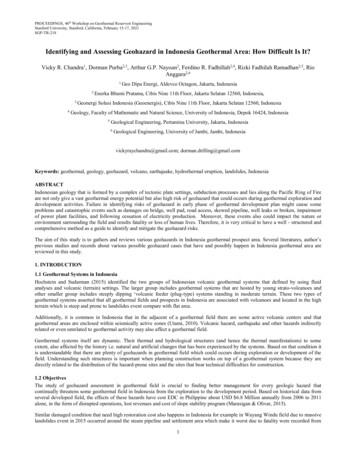
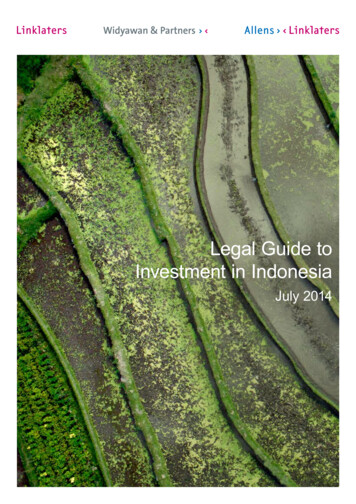
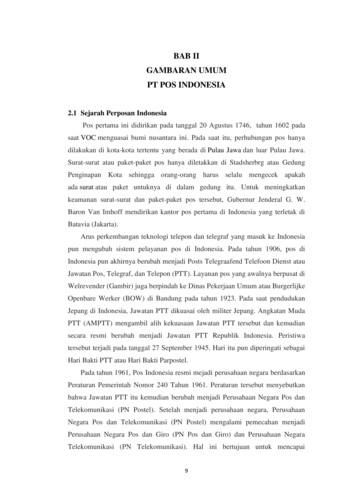
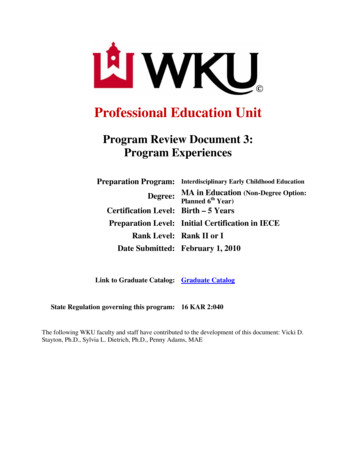
![JMK-nas-8a- [20-1-2018] revision Purwanto - Universitas WR Supratman](/img/15/cekplagiasi-plagiasi-20marketing-20politik.jpg)

